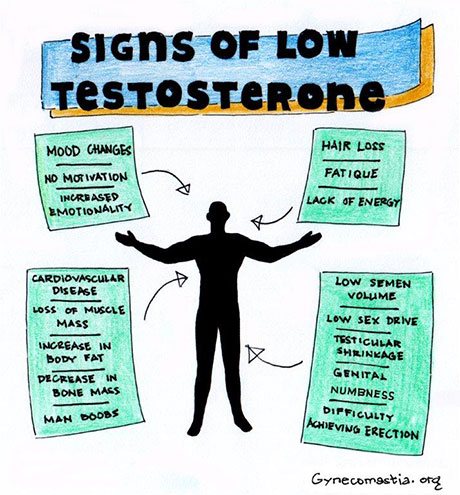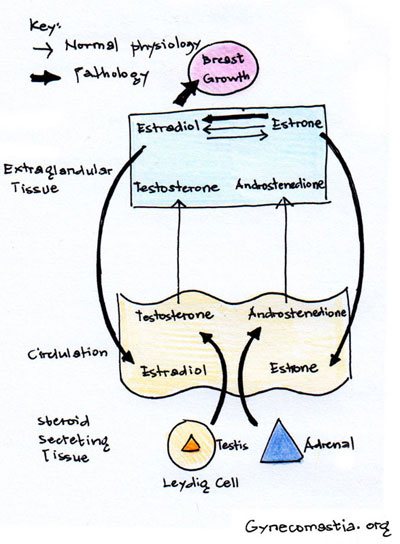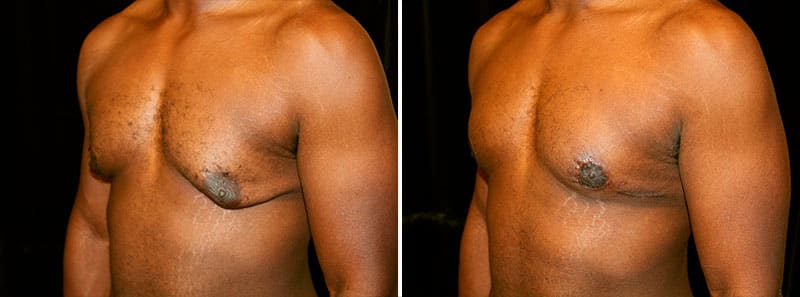Estrogen in Men: Signs and Symptoms
Both men and women possess the same hormones, testosterone, and estrogen. The estrogen levels in women are higher, and the serum testosterone levels in men are higher. As is the case in women, estrogen also plays a significant role in the sexual function of men. There are some medications that may cause an excessive amount of estrogen to be produced in the body.
Your hormone levels can be identified by the results of the test if your estrogen or progesterone levels are too high or too low. In addition, you may also develop low testosterone or low progesterone levels in your body, which may disturb your hormonal imbalance. It is possible for men or women to experience symptoms of menopause associated with high estrogen levels, or even low testosterone levels. Blood tests are often used to determine whether your levels of a particular substance are too high or too low.
Both high and low estrogen levels can cause some long-term complications or indicate that there’s an underlying condition that should be treated. Here’s what you need to know.
How Much Estrogen Does a Man Normally Produce?
Estrone and estradiol are the two major types of estrogen in men. Picograms are measured per milliliter (pg/ml). The following summarizes the averages:
There are two types of estrogen: estrone and estradiol
- Prepubescent male, between 16 and 13 picograms
- Pubescent male weighing between 60 and 40 picograms
- Male adult, 10-60 picograms to 10-40 picograms
Here Are Some of The Main Symptoms of High Estrogen Levels
- Problems related to fertility. A key factor in the production of sperm is the hormone estrogen. High estrogen levels have been shown to adversely affect sperm production and, as a consequence, can make it more difficult for women to conceive.
- Gynecomastia in men. Manboobs are an enlargement of the male breast tissue caused by increased estrogen levels in the body. Gynecomastia can be caused by high levels. Breast tissue in this area is abnormally high.
- The condition is known as erectile dysfunction (ED). Having an increase in estrogen can affect the balance of hormones that are essential for obtaining and maintaining an erection. Low testosterone is especially relevant if you are also experiencing slowed growth. Short stature or delayed puberty may also be a consequence of excess estrogen.
- Closure of the epiphysis. It is possible for male adolescents to have short stature when estrogen levels are high.
The following is a list of possible symptoms of high estrogen that may occur in conjunction with other hormone imbalances:
- Reduced sexual activity
- Semen concentration of sperm is reduced
- Feeling fatigued
- Loss of hair on your entire body
- Muscle mass is decreasing
- Reduction in the size of the penis and testicles
- (hot flashes) a sudden feeling of being hot
- Having difficulty concentrating
- Gynecomastia – male breast enlargement
Causes of High Estrogen in Men
Your body is capable of producing a great deal of estrogen, either independently or in conjunction with less testosterone. Some medications and substances can increase estrogen levels, including:
- Anxiety
- A type of antibiotic
- There are many different herbs and natural substances, such as ginkgo or ginseng
- Phenothiazines (used to treat mental disorders) are pharmacologically active
You can also inherit high estrogen levels from your parents. A number of health conditions can also lead to an increase in estrogen levels, including:
- Gaining weight under stress or becoming obese
- Liver diseases
- Hypergonadism, for instance, affects hormone balances
Men With Low Estrogen Levels Can Cause Gynecomastia or Enlarged Breasts in Men
Low estrogen levels are not usually a problem for men.
However, you may experience some of the same symptoms if you are deficient in estrogen. It is because estrogen imbalances can occur as a consequence of hypogonadism, a condition in which your body produces fewer hormones than normal.
Hypogonadism decreases levels of estrogen, testosterone, and other hormones, which causes many of the symptoms that have been associated with high estrogen levels.
Causes of Low Estrogen
Low estrogen due to hypogonadism can have a number of possible causes, including:
- Hyperparathyroidism, also known as Addison’s disease
- Testicles that do not descend because of kidney or liver problems
- Radiation exposure
- Surgery on the penis or testicles
- Pituitary gland conditions
- sarcoidosis
- The tuberculous infection
- histiocytosis
- The condition of being obese
- Loss of weight quickly
- Nutritional deficiencies and lack of vitamins
- Neurosurgery
- The pituitary gland has a tumor on it or close to it
If your doctor suspects that you may have low or high levels of estrogen, they will conduct a laboratory blood test.
Your results should be available within a week. The level of estrogen in your blood is measured in picograms per milliliter (pg/mL). Your doctor will inform you of the next steps after receiving your results.
There is no need to take any action if they appear to be normal. Your doctor will make a recommendation if your levels are too high or too low so that you can achieve a balanced estrogen level.
Managing Estrogen Levels in Men
Here are some of the possible treatments a doctor may recommend to help control your estrogen levels.
Medication
Aromatase inhibitors prevent an enzyme known as aromatase from turning androgens or testosterone into estrogen. In spite of this, research indicates that they do not have such a powerful effect.
The medication is not usually prescribed as a treatment, but if clinically indicated, it can help patients reduce their estrogen levels. Anastrozole (Arimidex) or exemestane (Aromasin) can be taken as medications.
Aromatase inhibitors are not as effective for the treatment of gynecomastia as SERMS, but they may have other clinical applications, including those involving breast cancer or boys with short stature. It is also possible to obtain aromatase inhibitors in natural forms, such as wild nettle root, maca, and grapeseed extract. It is important to discuss these natural options with your healthcare provider first.
Low Estrogen Diet
Maintaining a low estrogen level can also be achieved by making dietary changes. Fiber-rich, low-fat diets are best for controlling estrogen levels. The following foods may be included in this type of diet:
- As a result of cruciferous vegetables (such as broccoli and kale) containing phytochemicals, estrogen is decreased
- Aromatase activity is naturally reduced by mushrooms such as shiitake and portobello
- As well as whole grains, sesame seeds and flaxseeds provide a micronutrient called polyphenols, which is found in many grains, including oats, corn, and rice
- Green tea also contains polyphenols
- Phytochemicals in pomegranates block estrogen production
The consumption of meat treated with synthetic hormones may contain estrogen, so they should be avoided. In addition to the following products, you should also avoid:
- Wraps or containers made of plastic that absorb food
- Paraben-containing shampoos that contain estrogen
Exercise and Fitness to Reduce Gynecomastia
- Maintaining a healthy weight can also reduce your estrogen levels:
- Make a plan to get a physical to check your overall health
- You should exercise for 15 to 30 minutes every day, and gradually increase the amount of time as you become comfortable
- Alternate between cardio and strength training on different days
- Take up regular exercise by joining a gym
Risks of Having High Estrogen as a Grown Adult
High levels of estrogen in a male increase your risk of certain conditions, including:
- Gynecomastia or large male breast tissue
- A diabetic state
- Strokes caused by blood clots
- Breast and prostate cancers are among these cancers.
Conclusion:
Having high estrogen levels or having low estrogen levels can both cause various long-term health problems or be a signal that a deeper problem must be addressed.
In case you think you may have abnormal levels of estrogen in your body, you should consult with a gynecomastia doctor as soon as possible.
FAQ’s
Can Gynecomastia Go Away?
Gynecomastia often goes away without treatment in less than two years. Treatment may be necessary if gynecomastia doesn’t improve on its own or if it causes significant pain, tenderness, or embarrassment. Enlarged breasts in men can also be psudogynecomastia and exercise and diet can reduce the fatty tissue of the breast to enhance a body changes.
How Do You Make Gynecomastia Go Away?
Gynecomastia is very common among men aged between 50 and 85. Various conditions can result in this condition, including obesity and type 2 diabetes, as well as side effects of medications. It is possible to reduce the amount of breast tissue by treating or managing these underlying health conditions, or by ceasing use of any medications that may be causing gynecomastia. Enlarged breasts in men and boys is a treatable condition and your doctor can guide you in the right direction.
It is possible to undergo male breast reduction surgery if gynecomastia does not resolve on its own. In addition to or instead of surgery, hormone therapy, or other medication, men who are willing to wear compression shirts can reduce the appearance of gynecomastia.
Losing weight may help to improve the condition of breast tissue resulting from the growth of fat (pseudogynecomastia). Pseudo-gynecomastia can sometimes be treated with liposuction in order to remove excess fat.
Does Testosterone Reduce Gynecomastia?
You should also consider treating low T in addition to gynecomastia. Age is associated with a decline in testosterone levels in men. It is for this reason that many older men seek testosterone replacement therapy. There are a number of treatment options available:
- Gels for the skin
- A patch
- The injection of drugs
The results of testosterone replacement therapy are usually noticeable in men. The following often improves for them:
- Energized
- Intense sexual desire
- An erection
- The act of sleeping
- Mass of muscle
Additionally, their outlook and mood may improve as a result of the treatment. Gynecomastia can be resolved with testosterone replacement therapy in men who have low testosterone levels.
Can Gynecomastia Go Away with Exercise?
Is it possible to remove gynecomastia by exercising? The answer is unfortunately no. Patients who make lifestyle changes such as exercising more or eating a healthier diet will find plenty of health benefits, but changes in gynecomastia symptoms are unlikely to occur. The root cause of gynecomastia is not related to weight at all – rather, it is commonly caused by hormones that cause male breast tissue to grow. This is an important distinction between gynecomastia breast gland tissue and pseudogynecomastia, which is a similar condition. Unlike gynecomastia, which is caused by a number of factors, including hormones and specific medical conditions, pseudogynecomastia is only caused by obesity.
Most patients lack good information regarding whether they suffer from gynecomastia or pseudogynecomastia, and without this knowledge, it is harder to determine how to treat their gynecomastia condition. There are several ways to distinguish between, despite the fact gynecomastia or pseudogynecomastia that their primary symptom is the appearance of the breasts. Consulting a gynecomastia doctor can help in the diagnosis.




